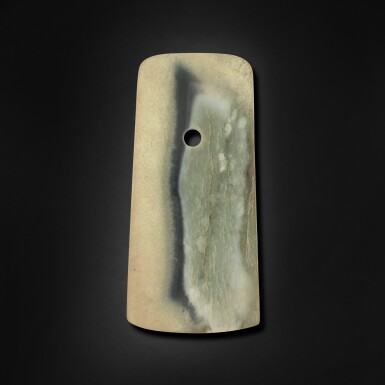Auctions
Buy Now
Collectibles & More
Books & Manuscripts
Chinese Art
Chinese Art

Auction Closed
September 18, 08:03 PM GMT
Estimate
200,000 - 300,000 USD
Lot Details
Description
Length 7⅛ in., 18.2 cm
Collection of Gustav Heinrich Ralph von Koenigswald (1902-1982), acquired in Beijing circa 1939.
Of simple yet striking form, the present lot numbers among the finest jade axes produced in ancient China. A dark central striation meandering through the middle of the blade accentuates its subtle shape and contrasts the enchanting light green stone with the serenity of the blue-gray opposite. Although yue may trace their origins to more humble Neolithic stone tools, by the time of the Shang period, they had reached lofty heights as imposing ceremonial weapons hewn from jade – true symbols of power and majesty. Indeed, this yue is a prime example of the heights of jade craftsmanship; worthy only to be held by the most powerful of leaders.
Three closely comparable jade blades are known. One is preserved in the Fogg Museum, Cambridge (accession no. 1943.50.96) (Fig. 1), donated by Grenville L. Winthrop in 1943, illustrated in Max Loehr, Ancient Chinese Jades from the Grenville L. Winthrop Collection in the Fogg Art Museum, Harvard University, Cambridge, Mass., 1975, pl. 345; the second, from the Drummond Collection, is in the American Museum of Natural History, New York (accession no. 70.3/ 3015), and published in Minao Hayashi, Yang Meili trans., Zhongguo guyu yanjiu [Studies of ancient Chinese jades], Taipei, 1997, p. 317, fig. 6-68; and the third from the Guennol Collection, sold in these rooms, 22nd March 2023, lot 525 (Fig. 2). Although the Winthrop and Drummond jades are both oriented horizontally with three apertures, in terms of stone color and natural markings they bear a remarkable resemblance to both the present yue and the Guennol piece, possibly indicating that these works all originated from the same stone.
Jade yue of this quality from the Shang and Zhou dynasties are very rare. See a Middle Shang dynasty jade yue of a smaller size, excavated in Xinzheng county, Henan province, published in Yang Boda, ed., Zhongguo yuqi quanji [The complete collection of Chinese jade], vol. 1, Shijiazhuang, 2005, p. 134, pl. 24; and another with a curved edge and a short, protruding shaft, excavated from the famous Fuhao Tomb in Yinxu, published in Yinxu fuhao mu / Tomb of Lady Hao at Yinxu in Anyang, Beijing, 1980, pl. CXVIII. For a Zhou dynasty jade yue, see a slightly smaller example of a similar stone, from the Bahr Collection, now in the Field Museum of Natural History, Chicago, illustrated in Berthold Laufer, Archaic Chinese Jades Collected in China by A.W. Bahr Now in Field Museum of Natural History Chicago, New York, 1927, pl. IV.
While it is nearly impossible to trace the geographical origins of this magnificent yue, its stone body, characterized by the distinct variegated colorations with dark markings, can be compared to some of the ritual jades discovered in Gansu province. A group of such examples from the Qijia culture is published in Gu Fang, op. cit., vol. 15, including a jade bi disc, excavated from Huangniangniangtai, Wuwei city, now in the Gansu Provincial Museum, Lanzhou, pl. 1; another, discovered from Houliugou village, Jingning, currently preserved in the Jingning Museum, pl. 4; and a jade cong, unearthed in Lintao, now in the Dingxi Museum, Dingxi, pl. 31.
Gustav Heinrich Ralph von Koenigswald (1902-1982) was a world-renowned archaeologist of early humans, whose work in Java contributed to the identification of homo erectus. During a brief stay in Beijing in 1939, Koenigswald found a new outlet for his love of geology and archaeology in collecting Chinese jades. Benefiting greatly from the recent groundswell in global enthusiasm for Chinese artifacts and an increase in excavations across the country, Koenigswald amassed a remarkable collection over the course of the year, likely sourced from high profile dealers across Beijing.